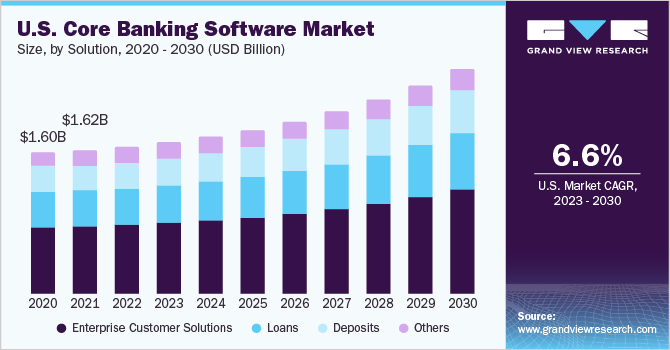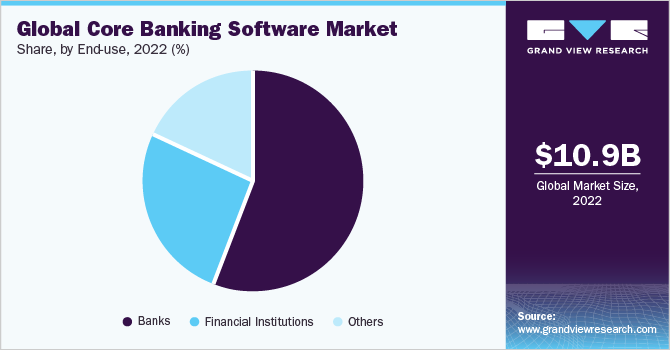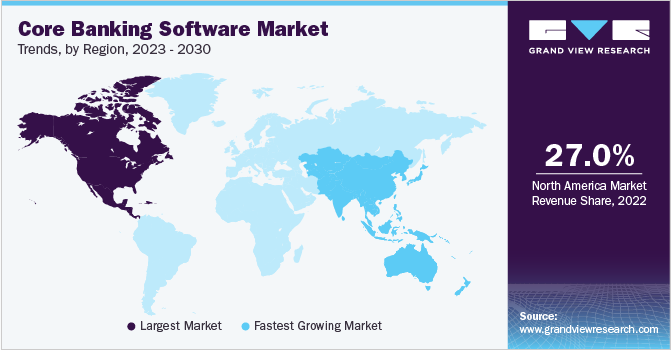- Home
- »
- Next Generation Technologies
- »
-
Core Banking Software Market Size & Share Report, 2030GVR Report cover
![Core Banking Software Market Size, Share & Trends Report]()
Core Banking Software Market Size, Share & Trends Analysis Report By Solution (Deposits, Loans), By Service (Professional Service, Managed Service), By Deployment (Cloud, On-premise), By End-use, By Region, And Segment Forecasts, 2023 - 2030
- Report ID: 978-1-68038-496-3
- Number of Report Pages: 140
- Format: PDF, Horizon Databook
- Historical Range: 2017 - 2021
- Forecast Period: 2023 - 2030
- Industry: Technology
Report Overview
The global core banking software market size was valued at USD 10.89 billion in 2022 and is anticipated to grow at a compound annual growth rate (CAGR) of 9.3% from 2023 to 2030. The market growth can be attributed to the rising incorporation of technology to provide core banking operations and services. Digitized operations have enhanced banking service quality and reduced turnover times. Technological advancements have also enabled financial institutions to adapt to changing customer needs, a prominent example being the provision of omnichannel banking access.

In addition to providing customers the ability to manage accounts remotely through online banking and mobile channels, core banking software has multiple other benefits. Core banking software solutions connect multiple branches to a centralized system making them interconnected and allowing for efficient search and comparison of data. Banks can leverage core banking software to analyze data and improve internal processes. Moreover, through transaction monitoring and screening, core banking solutions help detect and prevent money laundering.
The pace of technological innovation and adoption has gathered tremendous pace across sectors. Integrating the latest technologies, such as generative artificial intelligence in banking and financial activities, can help firms differentiate from the competition and gain a competitive edge. According to a study conducted by Accenture in March 2023, covering over 49,000 customers, 67% mentioned using branch services for very specific and complex problems that require physical presence. Moreover, the survey estimates that banks can boost revenue by up to 20% through better engagement with primary customers.
Core banking digitization can make banking transactions more effective. A unified system enables seamless access to customer information and reduces the need for redundant data entry, resulting in faster and more accurate transactions. Additionally, core banking systems support real-time processing, enable instant account and transaction updates, and faster payments and fund transfers. Furthermore, core banking software improves overall security features and fraud detection mechanisms, ensuring the safety of transactions and protecting customers from potential risks.
However, the complex nature of banking operations may pose some challenges. Several financial institutions are in the early phases of transitioning from legacy systems to digital solutions for better banking. However, the transition is bringing about privacy concerns associated with making the shift which plagues the growth of the market. However, core banking solution providers are innovating and providing customized solutions to meet the needs of banks and financial institutions.
COVID-19 Impact Analysis
The growth of the market was negatively impacted by the COVID-19 pandemic. Multiple sectors have experienced substantial repercussions due to the pandemic, resulting in a worldwide economic deceleration. This unforeseen circumstance underscored the necessity for banks worldwide to implement their strategies effectively. Many systems related to loan accounting, deposit accounting, and core banking require significant adaptation for seamless operational flexibility on a large scale. Consequently, global banks and financial institutions are placing significant emphasis on devising strategies for business continuity. Their main priority is ensuring the uninterrupted operation of branch distribution and customer service functions.
Solution Insights
The enterprise customer solutions segment dominated the market in 2022 and accounted for more than 46.0% share of the global revenue. The segment’s growth can be attributed to banks and financial institutions adopting a collaborative infrastructure and adopting new solutions. For instance, in April 2023, Intellect Design Arena’s retail banking arm, Global Consumer Banking, launched a core banking platform called eMACH.ai that allows the creation of custom products using artificial intelligence. Leveraging emerging technologies such as machine learning and artificial intelligence, personalized products and services can be provided, thus enhancing the customer experience.
Core banking solutions for loans encompass a comprehensive set of digital tools designed to streamline and optimize the loan management process within a financial institution. The loan solutions enhance operational efficiency, customer experience, and regulatory compliance throughout the lifecycle of loan products. Moreover, automation of the loan application and approval process, including data capture, credit scoring, and documentation verification, accelerates loan approval times and reduces manual errors. Thus, the loan segment is expected to witness significant growth.
Service Insights
The professional service segment dominated the market in 2022 and accounted for more than a 76.0% share of the global revenue. Core banking software must be tailored to meet each financial institution's requirements and workflows. Professional service providers help banks customize the software to meet their business needs. The primary growth factor for the professional service segment is the increasing need for support services at each level of software deployment, such as the pre-implementation of scope and consulting, project management, and integration.
The managed service segment is expected to register the highest growth over the forecast period. As banks grow and evolve, their technology requirements change as well. Managed services providers ensure that the integrations can scale to accommodate increased transaction volumes and new applications, providing a flexible and future-proof integration architecture. Efficient managed services minimize downtime during integration, preventing disruptions to banking services.
Deployment Insights
The on-premise segment dominated the market in 2022 and accounted for more than 59.0% share of the global revenue. When building an on-premise system, businesses assume full responsibility for integration and any IT-related and security issues. Companies with legacy platforms often partner with IT service providers to recover data and reduce security concerns and operational costs. It provides more control over the operational infrastructure.
The cloud segment is anticipated to register the highest growth over the forecast period. Financial institutions and banks with on-premise infrastructure are focusing on adopting cloud-based solutions to compete against more innovative digital opponents. Cloud technology helps automate workflows and operations, increasing efficiency, cost savings, and security. Cloud-based core banking solutions are flexible and easy to expand or reduce on demand, thereby meeting the IT requirements of the target organization.
End-use Insights
The banks segment dominated the market in 2022 and accounted for more than 56.0% share of the global revenue. The segment's growth can be attributed to the rising investments in modern IT infrastructure. Automated systems ensure accurate data entry and processing, minimizing erroneous entries. Access to real-time data and advanced analytics enables banks to gain valuable insights into customer behavior, preferences, and financial trends, helping them make data-driven decisions.

The financial institutions segment is expected to grow significantly over the forecast period. Financial institutions widely adopt core banking software to prevent theft and fraud with real-time banking facilities. The rising adoption rate can also be attributed to the need to fill the gap between customer expectations and traditional banks' operations. These factors are expected to create growth opportunities for the financial institutions segment.
Regional Insights
The North American region dominated the market for core banking software in 2022 and accounted for over 27.0% share of global revenue. The North American region is known for early technology adoption across sectors. For instance, in February 2023, Arvest Bank launched its first equipment financing product on cloud technology. The rising emphasis of prominent regional banks to modernize core infrastructure is expected to drive regional growth.

Asia Pacific is anticipated to emerge as region with fastest market growth during the forecast period. The Asia Pacific region is marked by a large number of people who do not have access to bank accounts. The proliferation of various fintech companies in the region is expected to drive the demand for banking products and services. Moreover, financial inclusion initiatives in the region are expected to bode well for the growth of the Asia Pacific core banking software market over the forecast period.
Key Companies & Market Share Insights
The market displays a moderate level of fragmentation and faces robust competition from established entities within the sector. Leading players in the market employ various strategies, such as forming joint ventures, establishing partnership agreements, engaging in mergers and acquisitions, introducing innovative products, expanding into new geographical regions, and intensifying their focus on research and development initiatives. To ensure their enduring presence in the market, these prominent players adopt these strategies. For instance, in April 2023, Regions Bank, headquartered in the United States, forged a partnership with Temenos Group. This collaboration aims to modernize the bank's existing systems, deliver personalized and robust banking solutions, and elevate the overall quality of customer experiences.
Providers of core banking solutions concentrate on creating pre-built financial solutions that offer a distinctive strategic edge over their competitors. These vendors prioritize leveraging feedback from clients to enhance the functionalities of their digital platforms and financial offerings. They are delivering solutions tailored to the specific professional requirements of banks and financial institutions that are mindful of the constraints of their core architecture platforms. Some prominent players in the global core banking software market include:
-
Capgemini
-
Finastra
-
FIS
-
Fiserv, Inc.
-
HCL Technologies Limited
-
Infosys Limited
-
Jack Henry & Associates, Inc.
-
Oracle Corporation
-
Temenos Group
-
Unisys
Core Banking Software Market Report Scope
Report Attribute
Details
Market size in 2023
USD 11.57 billion
Revenue forecast in 2030
USD 21.61 billion
Growth rate
CAGR of 9.3% from 2023 to 2030
Base year of estimation
2022
Historical data
2017 - 2021
Forecast period
2023 - 2030
Quantitative units
Revenue in USD million/billion and CAGR from 2023 to 2030
Report coverage
Revenue forecast, company market share analysis, competitive landscape, growth factors, and trends
Segments covered
Solution, service, deployment, end-use, region
Regional scope
North America; Europe; Asia Pacific; Latin America; MEA
Country scope
U.S.; Canada; Germany; U.K.; France; China; India; Japan; Australia; South Korea; Brazil; Mexico; Kingdom of Saudi Arabia (KSA); UAE; South Africa
Key companies profiled
Capgemini; Finastra; FIS; Fiserv, Inc.; HCL Technologies Limited; Infosys Limited; Jack Henry & Associates, Inc.; Oracle Corporation; Temenos Group; Unisys
Customization scope
Free report customization (equivalent to up to 8 analysts working days) with purchase. Addition or alteration to country, regional & segment scope
Pricing and purchase options
Avail customized purchase options to meet your exact research needs. Explore purchase options
Global Core Banking Software Market Report Segmentation
The report forecasts revenue growth at global, regional, and country levels and provides an analysis of the latest industry trends in each of the sub-segments from 2017 to 2030. For this study, Grand View Research has segmented the global core banking software market report based on solution, service, deployment, end-use, and region.
-
Solution Outlook (Revenue, USD Million, 2017 - 2030)
-
Deposits
-
Loans
-
Enterprise Customer Solutions
-
Others
-
-
Service Outlook (Revenue, USD Million, 2017 - 2030)
-
Professional Service
-
Managed Service
-
-
Deployment Outlook (Revenue, USD Million, 2017 - 2030)
-
Cloud
-
On-premise
-
-
End Use Outlook (Revenue, USD Million, 2017 - 2030)
-
Banks
-
Financial Institutions
-
Others
-
-
Regional Outlook (Revenue, USD Million, 2017 - 2030)
-
North America
-
U.S.
-
Canada
-
-
Europe
-
Germany
-
U.K.
-
France
-
-
Asia Pacific
-
China
-
India
-
Japan
-
Australia
-
South Korea
-
-
Latin America
-
Brazil
-
Mexico
-
-
Middle East & Africa
-
Kingdom of Saudi Arabia (KSA)
-
UAE
-
South Africa
-
-
Frequently Asked Questions About This Report
b. The global core banking software market size was estimated at USD 10.89 billion in 2022 and is expected to reach USD 11.57 billion in 2023.
b. The global core banking software market is expected to grow at a compound annual growth rate of 9.3% from 2023 to 2030 to reach USD 21.61 billion by 2030.
b. North America dominated the core banking software market with a share of 27.69% in 2022. This is attributable to the large-scale adoption of advanced core banking software by prime banks in the North American region.
b. Some key players operating in the core banking software market include Capgemini, FIS, Fiserv, HCL Technologies Limited, Infosys Limited, Jack Henry & Associates, Inc., and Oracle Corporation.
b. Key factors that are driving the core banking software market growth include increasing customer demand for advanced banking technologies and growing demand for managing customer accounts from a single server.
Share this report with your colleague or friend.
![gvr icn]()
NEED A CUSTOM REPORT?
We can customize every report - free of charge - including purchasing stand-alone sections or country-level reports, as well as offer affordable discounts for start-ups & universities. Contact us now
![Certified Icon]()
We are GDPR and CCPA compliant! Your transaction & personal information is safe and secure. For more details, please read our privacy policy.
We are committed towards customer satisfaction, and quality service.
"The quality of research they have done for us has been excellent."





